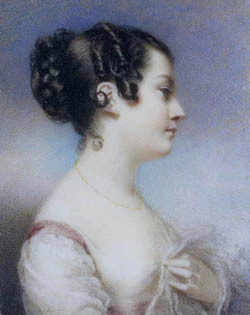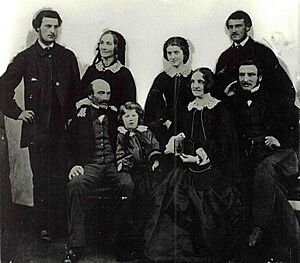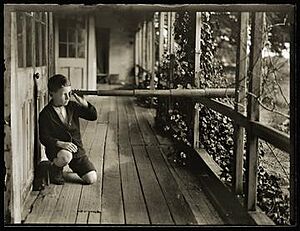McCrae Homestead facts for kids
The McCrae Homestead is a very old house in McCrae, Victoria, Australia. It was built in 1844 by Andrew McCrae, a lawyer, and his wife Georgiana Huntly McCrae, a talented artist. Their home was at the bottom of Arthurs Seat, a small mountain, close to the water of Port Phillip. Today, the National Trust of Australia looks after the homestead. It is open for visitors, and volunteers share its history.
This homestead is one of the oldest in Victoria. It shows how early settlers built homes and farms using local materials. They used simple building methods. The house walls are made from horizontal timber slabs. These slabs came from local trees like stringybark, found on the mountain. Workers used mud and sticks, bark, and wooden shingles to build the house.
Georgiana designed the house, including special features like the Count Rumford fireplace. The 3,000 bricks for the fireplace came by boat from Williamstown. The house is small but well-planned. It had a separate kitchen, which was common then to prevent fires. A drawing by Georgiana from 1850 shows the house layout exactly as it is today. A small part was added in the 20th century.
Contents
Homestead History and Care
Early Owners and Changes
The McCrae family lived in the homestead from 1844 to 1851. After they left, the Burrell family moved in. They lived there for 74 years, from 1851 to 1925. The inside of the house stayed mostly the same. Only two bay windows were added.
John Twycross, a descendant of the Burrells, visited the house often as a child. Years later, he could still remember what each room was used for. He remembered where his bed was and where his aunt roasted scallops in the kitchen fireplace. He also recalled a piano in the dining room. This piano had been dropped into the sea during its journey and was hard to tune afterward.
New Owners and Restoration
Kate Burrell passed away in 1925. In 1927, the Williams family bought the house. The land around it was divided into smaller blocks. The Williams family made some changes to the house. They might have covered the original walls. They also turned the outside kitchen into a small apartment.
From 1938 to 1947, the homestead was a private nursing home. It was sold again in 1952. From 1952 to 1955, the house was split into two apartments. These were rented out for holidays, which was a new idea on the peninsula after World War II.
In 1961, George Gordon McCrae, Georgiana's great-grandson, bought the house back. After he died, his son Andrew gave it to the National Trust of Victoria in 1970. By then, the land around the house had shrunk a lot. The inside of the house was in poor condition. But the homestead was still standing. It was the oldest wooden building left in Victoria.
In the 20th century, the Burrells had put a corrugated iron roof over the original wooden shingles. This was for collecting rainwater and protecting against bushfires. When the National Trust restored the homestead, they found the original shingles underneath. The newer roof had kept them safe since 1844.
Local Building Connections
Heronswood and Local Materials
Many early buildings in the area used materials found nearby. Heronswood is a large home built in 1874. It stands above Anthonys Nose and is now open to the public. The main building of Heronswood was made from a rare green granite. This granite came from the original McCrae property. Both McCrae Homestead and the first building at Heronswood had roofs made from local messmate timber shingles.
The McCrae Family Story
Early Settlers in Victoria
The McCraes were among the first settlers in the new colony of Victoria, Australia. Andrew arrived from England in 1839. Georgiana followed him in 1841 with their four young sons.
Georgiana's oldest son, George Gordon McCrae (1833–1927), wrote about his time at Arthur's Seat. He kept diaries and made sketches and paintings. The McCraes were one of the first families to settle on the Mornington Peninsula. They built their home near where the McCrae Lighthouse would later stand. It overlooked Port Phillip. The McCraes also knew Arthur's Seat as Wango, the name given to this granite outcrop by the Bunurong people.
In 1934, one of Georgiana's grandsons, the poet Hugh McCrae, published her diaries. The book was called "Georgiana's Journal." It covered her life from leaving England in 1838 to 1865. This included her years at Arthur's Seat from 1844 to 1851. The diary also had letters from her children. George Gordon, Willie, Sandy, and Perry were sent ahead of their parents to Arthur's Seat with their tutor, John McClure. Their letters showed their excitement. They helped build huts, fished from the beach, and explored the wild area. They also became friends with the Bunurong people. The Bunurong taught them their language and songs. The four boys learned to fish with wooden spears. In 1847, George wrote a detailed description of a Corroboree.
John McClure was born on the Isle of Skye. He had a good education. So, the McCrae sons received a fine education while living a pioneer life. One of the original huts on the property was the Schoolhouse. It was nicknamed "The University of Arthur's Seat." The Burrell family children later used this same name. In the 1920s, John Twycross took a photo of the hut, which was leaning a bit by then.
A watercolor painting from the late 1850s by Edward La Trobe Bateman was titled "Mr McClure's Hut."
Georgiana's Diary Entries
On July 19, 1846, Georgiana wrote in her diary about the homestead:
- "It has been more than a year since we settled, or as the Aboriginal people say, Quambied (camped) on Arthur's Seat."
- "Our house is built of gum-tree slabs. These are held horizontally by grooved corner-posts. The same method is used for windows and doors."
- "The biggest room has a table and chairs, but no pictures. Instead, you can see the actual landscape through gaps between the planks!"
- "Besides the main house, we recently built some rooms using wattle and daub. They just need plastering."
The rooms inside the homestead were finished soon after this. They show Georgiana's artistic touch and good taste. The house is furnished with original items and furniture passed down from Georgiana McCrae to her family.
The Homestead View
Georgiana also wrote about the view from the homestead:
- "Our house is on a sandy terrace, about 200 yards from the beach."
- "We can see the Shortlands Bluff lighthouse and the two points, Nepean and Lonsdale."
- "On clear days, we can faintly see Cape Otway in the west."
This amazing view is now mostly hidden by new buildings. However, you can still see it from Seawinds, a park higher up on Arthurs Seat mountain.
A Pioneer Woman's Life
Georgiana's diary entries also describe daily life:
- July 22, 1845: "The bay is calm like a mirror. Lanty and Neale went fishing. Tuck fixed the two halves of our door. This keeps out the dogs and geese, and Master Tommy. I had to use my last packet of candles, or the school-hut would be too dark."
- July 23, 1845: "The flour sacks have holes. So, I moved my dresses from the metal chest and filled it with flour instead."
- January 23, 1850: "The boys were at the beach. I heard someone shout excitedly. I went outside and saw Mr. McLure running towards the saw-pit. I followed quickly. I was surprised to see our cart tipped over. The two bullocks were hanging from the pole, which was caught in a native 'cherry' tree."
Her Family's Heights
On June 6, 1849, Georgiana recorded her family's heights:
- Fanny (almost 2 years old): 2 feet 8 inches
- Poppety (almost 5 years old): 3 feet 4 inches
- Lucia (7 and a half years old): 4 feet
- Perry (10 years, 7 months): 4 feet 3 3/4 inches
- Willie (14 and a half years old): 4 feet 7 inches
- Sandy (12 and a half years old): 4 feet 11 1/2 inches
- George (16 years old): 5 feet 2 1/2 inches
- Georgiana: 5 feet 3 1/2 inches
- Mr. McLure: 5 feet 7 inches
- Mr. Courtney and Mr. McCrae: 5 feet 10 inches
Leaving "The Seat"
Georgiana wrote about leaving her home on October 6, 1851:
- "A deeper sadness has come now. I must say goodbye to my mountain home, the house I built, the garden I made."
The Burrell Family
In 1851, the Burrell family arrived in Melbourne from Bury St Edmunds in England. They soon bought the Arthur's Seat Run from the McCrae family. They lived there and farmed cattle and sheep until 1925. Kate Burrell, the last of their children, died that year. You can still see newspapers from Bury St Edmunds lining one of the bedroom walls in the homestead. This shows the Burrells lived there.
The house was close to the bay, so it was drafty in winter. George Gordon McCrae, who had happy childhood days at the homestead, continued to visit the Burrells. Letters and photos show these visits. The Burrells were not able to keep the homestead, and it passed out of their family.
Both Georgiana's family and the Burrell family loved Arthur's Seat Run. They still have strong connections to the homestead. The National Trust of Australia now owns the homestead. This has helped preserve the house and its stories as an important part of Victoria's history.
McCrae Homestead Visitors Centre
This center is a gallery next to the original homestead. It holds collections from the McCrae and Burrell families from the 1800s. After a tour of the house, these galleries help visitors understand more about the homestead's history and life at that time.
McCrae Gallery
The McCrae Gallery has been recently updated. It displays original sketches and drawings by Georgiana McCrae. It also has costumes and other items. These show Georgiana's amazing life story. The exhibit shows her journey from being the daughter of a Scottish Lord to studying portrait painting in London. It covers her marriage to Andrew McCrae and their move to Melbourne. It also shows her life in Melbourne society and her love for her "mountain home." Here, she lived as a pioneer while still painting.
Georgiana kept a diary where she cleverly wrote about Victorian society. Many of her lively letters are kept in the Latrobe Library archives, part of the State Library of Victoria. You can see her paint box and brushes. There is also a Scottish kilt with Gordon tartan, made for one of her sons. The gallery also has some of her beautiful miniature paintings. These include a self-portrait and paintings of her children. There is also a painting of Eliza, a member of the Bunurong tribe. You can also see a childhood drawing by George Gordon McCrae. It shows a local corroboree in great detail.
Burrell Twycross Gallery
The Burrell Twycross Gallery tells the story of the Burrell family. They lived at the Arthur's Seat cottage for 74 years. The gallery has videos, original items, and furniture.
A rare large portrait of the Burrells is shown. It is an Ambrotype photograph taken in 1857. This was six years after they moved to Arthur's Seat. It shows the eight family members still living at the homestead. In 1870, Charlotte Burrell married John Twycross, a wool merchant, at the homestead. This was after her first husband passed away.
The Visions of Port Phillip exhibit shows photos by their son, John William Twycross. He was a banker and a pictorialist photographer in the early 1900s. He spent his holidays visiting his mother's family at Arthur's Seat Run. His work combines art and care for the environment. These large art prints are also very important historically. They capture what life was like on the peninsula long ago. The photos clearly show the strong bonds between early pioneer families on the Mornington Peninsula. They also show how much they relied on the bay for travel, fishing, and fun.
The Victorian Community History Awards are given out every year. They celebrate local history and excellent historical research. In 2010, Keith White and Will Twycross won the Best Audio-Visual / Multimedia award. They won for "Visions of Port Phillip: The Burrells of Arthur's Seat 1851–1925."
The judges said that a rich family photo album was the amazing material for a 14-chapter documentary. This documentary also used family stories. It showed how one of Melbourne's historic beach holiday areas developed. The images came from black and white photos by John William Twycross. They also used color slides taken in the 1950s by his son John Twycross on the Mornington Peninsula.
Information for the DVD came from family papers, spoken stories, and historical societies. It also came from the LaTrobe Library archives. One chapter, "Once Were Wetlands," used books and maps from the 1800s owned by the Twycross family. It also used an article from 1940 about the natural history of the Arthur's Seat area. This information was remembered by George Gordon McCrae later in his life.
John William Twycross was also part of a special group of cousins. This group included William Scoresby Routledge, an anthropologist, and John Milne, who invented the modern seismograph. His sister Lilian Twycross was a Melbourne opera singer.
Original papers and quotes from Alfred William Howitt, a family friend, are also interesting. They show his view of the Bay and the beauty of the land and sea at "The Seat." He wrote: "The Bay is covered with a haze as I look out... the smell of new hay comes in at the windows... a few hundred yards below the house is a belt of huge honeysuckle wattles, tea tree and she oaks edging the beach... over the tops you see the bay as smooth as a pond and six miles off are the heads and a blue broken ridge of hills."




